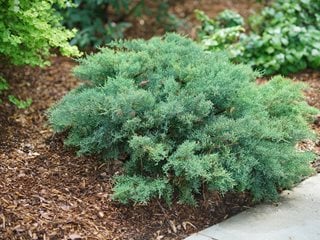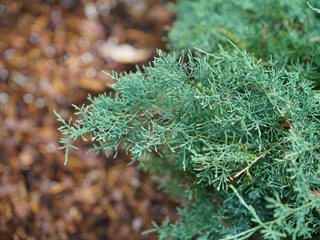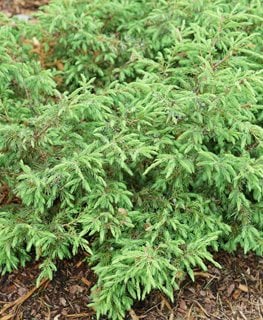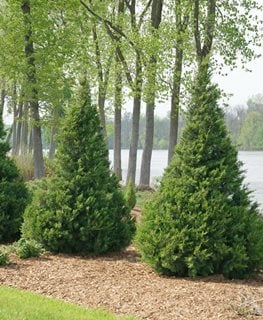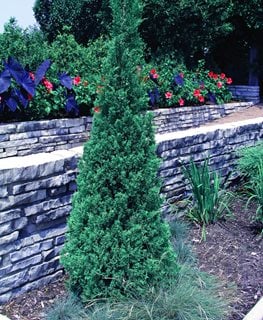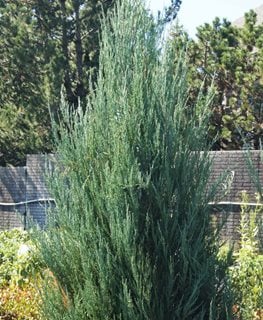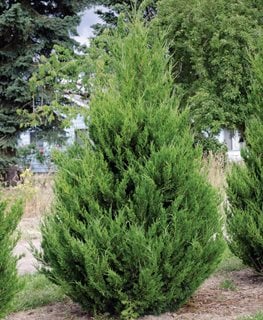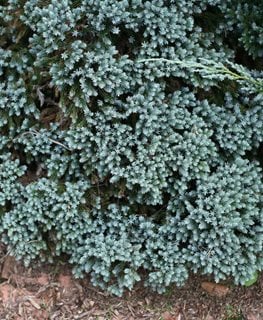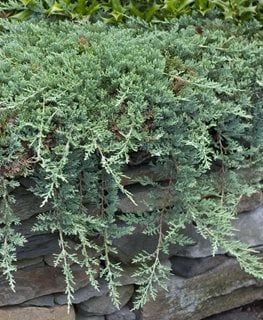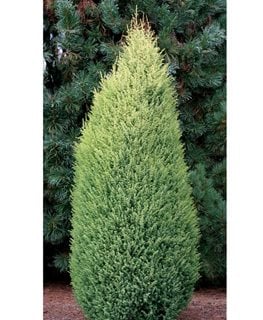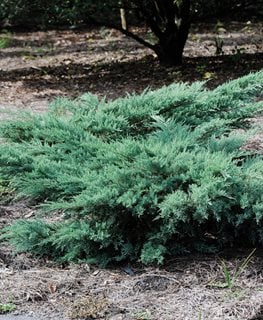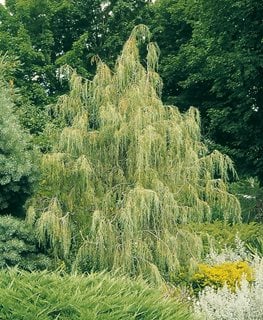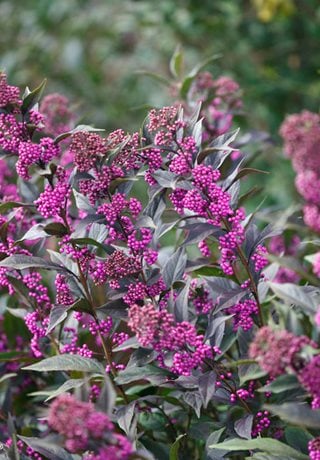GROWING JUNIPER SHRUBS AND TREES
Add year-round color and interest to your landscape with this versatile evergreenJuniper has long been a popular ornamental garden plant for its four-season interest, ability to grow in most regions, and virtually carefree nature. With shapes ranging from ground-hugging juniper bushes just 6 inches high to towering juniper trees 130 feet tall, and colors from steely blue to shimmering gold, there’s a juniper that suits nearly every landscape need. Whether you want to cover a slope for erosion control or create a privacy hedge, there’s one that fits the bill.
A member of the cypress family, there are some 50 to 60 species of these coniferous evergreens, which occur natively throughout the Northern Hemisphere, from the Arctic region to tropical Africa. Here are some garden-worthy varieties suitable for urban lots and other common residential landscapes.
On this page: The Basics | Planting | Care | Choosing the Right Juniper | Pictures | Alternatives | Landscaping Tips
- JUNIPER BASICS
- PLANTING JUNIPER
- JUNIPER CARE
- HOW TO CHOOSE THE RIGHT JUNIPER
- JUNIPER VARIETIES
- JUNIPER ALTERNATIVES
- JUNIPER LANDSCAPING TIPS
JUNIPER BASICS
Type:
Tree, shrub, or groundcover
Zones:
2-10, depending on variety
Height/Spread:
Upright, spreading or weeping habit, 6 inches to 130 feet tall and 1 to 25 feet wide
Exposure:
Nearly all varieties do best in full sun, though some benefit from afternoon shade in hotter climates.
Color and characteristics:
Evergreen leaves have prickly needle-like new growth, maturing to a flattened scale-like appearance. Foliage, which softens with age, comes in varying hues of green, as well as blue, silver, and gold, some acquiring bronze or other tones in winter. Tiny inconspicuous yellow or green flowers appear in spring. Male and female cones are both present on some varieties, making them self-pollinating, while others occur as separate male and female plants, which require a partner plant in order to achieve pollination. Female cones develop a fleshy berry-like appearance, starting out green and maturing to blue, while males more closely resemble miniature pine cones that are yellow or tan in color. Pollination time varies, with some varieties producing pollen several times a year. Female cones are aromatic and used as a spice and for medicinal purposes, but are most often used to flavor gin. Juniper berries are also a food source for songbirds and other wildlife. The resinous sap is combustible, making them a poor choice in areas with high fire danger. Other ornamental attributes may include attractive bark and twisted branching.
Toxicity:
Juniper berries, needles, and stems can be mildly toxic to dogs and cats if eaten, though most pets will leave plants alone due to the bitter taste. Ingestion is rarely if ever fatal, but can cause stomach upset, vomiting, diarrhea, and (in extreme cases) kidney problems. Consuming large amounts of the berries can result in aborted pregnancy in dogs. Contact your local poison control or veterinarian if your pet exhibits any symptoms. See more Common Poisonous Plants for Dogs and Cats.
PLANTING INSTRUCTIONS
When to plant:
Plant during milder months of spring or fall to avoid heat or cold stress.
Where to plant:
Choose a sunny site with well-draining soil.
How to plant:
Amend planting area with 20% organic matter. Dig a planting hole 2 to 3 times wider than the diameter of the root ball and slightly less deep than the rootball. Tease out roots if potbound, or make several slits in the rootball. Place plant in the hole with the top of the rootball slightly higher than the surrounding ground. Fill planting hole with loose soil and tamp down gently to remove air pockets, making sure not to cover the rootball. Water thoroughly and again once or twice weekly until established. Spacing depends on the variety and how they are used. Allow adequate spacing to ensure good air circulation, which will make plants less susceptible to fungal diseases.
CARE
Pruning and deadheading:
Junipers need little to no pruning so that plants retain their natural form. In early spring, cut out any dead branches, trim back errant growth and lightly shape as needed. Keep up with light pruning as young plants grow to keep them compact and healthy. Severe pruning of overgrown specimens can be a problem, as older growth at the center of the plant doesn’t regenerate. Cutting branches past live growth into dead zones can result in permanent bare gaps.
Soil:
Tolerant of most soil types, junipers prefer slightly acidic, organically rich soil with good drainage, as roots can rot in standing water.
Amendments & fertilizer:
When planted in optimal conditions, junipers need little to no supplemental fertilizer. If desired, apply an all-purpose slow-release fertilizer in early spring. Spread fertilizer around the root zone according to instructions and water in thoroughly.
Watering:
In most regions, junipers need little to no supplemental water once established. They are more likely to suffer from overwatering and resulting diseases than they are from underwatering. Irrigate newly planted specimens every week or two until roots have developed sufficiently, and keep plants moist during extreme drought and heat spells.
Diseases and pests:
Although virtually carefree when planted in the right conditions, they can be susceptible to a number of pests and diseases if not kept healthy. Insect problems include spider mites, juniper twig girdler, scale, juniper needle miner, bagworm, sawfly, and bark beetle. Diseases, which are primarily associated with overly wet soil, too much shade, or lack of air circulation, include twig and tip blight, phytophthora root rot, and cedar rust. Don’t plant near apple trees, as juniper are susceptible to cedar-apple rust, a fungus that can damage or destroy apple trees, as well as crabapple, hawthorn, and quince.
Deer resistance:
Deer will leave them alone for the most part, due to the sharp needles and bitter taste, though extreme conditions can result in deer grazing on plants they wouldn’t otherwise.
HOW TO CHOOSE THE RIGHT JUNIPER
With different sizes and forms to choose from, here are some tips to consider:
For borders and landscapes:
Choose varieties that will fit the scale of your property. Depending on the size and form, use as hedging, screening, in a mixed border, as foundation plantings, groundcovers or a stand-alone focal point. Make sure to allow room for plants to mature without becoming crowded.
For slopes and hillsides:
Mass low growers and groundcover types along a slope or hillside for low-maintenance erosion control.
For containers:
Plant a smaller specimen or dwarf type as a stand-alone accent in a container, or combine with other evergreen plants for year-round appeal.
JUNIPER VARIETIES
JUNIPER ALTERNATIVES
Many conifers have resinous sap, which can be flammable. In areas with high fire danger, substitute with broadleaf evergreens such as Oregon grape, boxwood, or rhododendrons.
JUNIPER LANDSCAPING TIPS
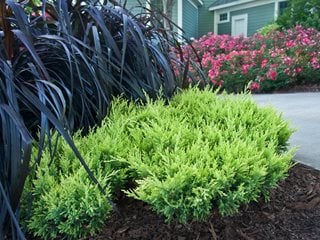
Good Vibrations® Gold juniper, paired with Graceful Grasses® Vertigo® purple fountain grass and Oso Happy® Candy Oh! landscape rose. Photo by: Proven Winners.
There are many ways to incorporate junipers into your landscape. Here’s how:
- Place a tall container by your entryway and plant a dwarf form as a year-round accent to enjoy up close.
- Plant a low- to medium-sized hedge along the front of your yard between the lawn and sidewalk as a living fence.
- Upright medium-sized forms can be planted in rows to break the landscape into individual garden rooms.
- Protect your home and landscape from desiccating winter winds by planting a row of tall junipers as a windbreak.
- Use upright specimens as a neutral backdrop in a mixed border to set off flowering annuals and perennials.
- For year-round color around your home, place small- to medium-sized varieties along the foundation where they won’t become overgrown and obstruct window views.
- Grow groundcover types in a rock garden in combination with alpine plants.
- Edge a pathway with a low-growing variety for year-round living color.
- Define a property line with a row of fast-growing tall junipers for privacy.
- Plant an individual specimen with appealing structure and color at the end of a pathway to draw your eye through the landscape.
- Use varieties that complement the style of your home and landscape. Weeping and groundcover forms are suitable to Asian-style landscapes, while columnar types evoke a formal or Mediterranean feel.
- Junipers combine well with a wide variety of trees, shrubs, perennials and groundcovers. Plant alongside companions with similar cultivation needs, such as dwarf bamboo, sage, roses, and ornamental grasses.
RELATED:
Shrubs 101
Evergreen Shrubs for All-Season Interest
17 Fast-Growing Shrubs for Your Garden
25 Low-Maintenance Shrubs
Best Evergreen Trees for Residential Gardens
